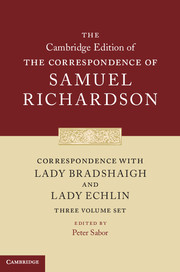Book contents
- Frontmatter
- Contents
- General Editors’ Preface
- Acknowledgements
- Chronology
- List of Abbreviations
- General Introduction
- Volume I Richardson’s Correspondence with Lady Bradshaigh and Lady Echlin, 1748–1753
- Volume I Richardson’s Correspondence with Lady Bradshaigh and Lady Echlin, 1748–1753
- Volume II Richardson’s Correspondence with Lady Bradshaigh and Lady Echlin, 1754–1757
- Volume II Richardson’s Correspondence with Lady Bradshaigh and Lady Echlin, 1754–1757
- Volume III Richardson’s Correspondence with Lady Bradshaigh and Lady Echlin, 1758–1762
- Volume III Richardson’s Correspondence with Lady Bradshaigh and Lady Echlin, 1758–1762
- Appendix I Lady Bradshaigh’s and Samuel Richardson’s Commentary on Clarissa
- Appendix II Lady Bradshaigh’s and Samuel Richardson’s Commentary on Sir Charles Grandison, Volume VII
- Appendix III Lady Echlin’s Alternative Ending for Clarissa
- Index
Appendix III - Lady Echlin’s Alternative Ending for Clarissa
Published online by Cambridge University Press: 16 July 2022
- Frontmatter
- Contents
- General Editors’ Preface
- Acknowledgements
- Chronology
- List of Abbreviations
- General Introduction
- Volume I Richardson’s Correspondence with Lady Bradshaigh and Lady Echlin, 1748–1753
- Volume I Richardson’s Correspondence with Lady Bradshaigh and Lady Echlin, 1748–1753
- Volume II Richardson’s Correspondence with Lady Bradshaigh and Lady Echlin, 1754–1757
- Volume II Richardson’s Correspondence with Lady Bradshaigh and Lady Echlin, 1754–1757
- Volume III Richardson’s Correspondence with Lady Bradshaigh and Lady Echlin, 1758–1762
- Volume III Richardson’s Correspondence with Lady Bradshaigh and Lady Echlin, 1758–1762
- Appendix I Lady Bradshaigh’s and Samuel Richardson’s Commentary on Clarissa
- Appendix II Lady Bradshaigh’s and Samuel Richardson’s Commentary on Sir Charles Grandison, Volume VII
- Appendix III Lady Echlin’s Alternative Ending for Clarissa
- Index
Summary
Lady Echlin's alternative ending for Clarissa is transcribed here from the manuscript, a fair copy housed at the Berg Collection, New York Public Library. The manuscript, of 82 leaves, quarto, is bound into a faded brown morocco volume, together with several other documents. One of these is an unsigned, undated pencil sketch of a middle-aged male subject, catalogued by the Berg Collection as Richardson but bearing no resemblance to existing portraits of him. The volume also contains five of Richardson's letters to Lady Echlin, a letter to him of 4 September 1760 signed by ‘Ethelinda, Charlotte and Henrietta’, and his pamphlet on the piracy of Sir Charles Grandison, The Case of Samuel Richardson, of London, Printer (1753). The volume was given to the Berg Collection in 1941 as part of a major donation by the American industrialist Owen D. Young (1874–1962), who had bought it at auction.
Lady Echlin's manuscript, unsigned and undated, is incomplete. It is preceded by prefatory remarks, in which she explains her intentions in writing her new conclusion for SR's work. The preface also reveals the existence of a draft, but not a fair copy, of the last part of the manuscript. Lady Echlin's remark that she would be happy to read her ‘whole long scribble’ to SR (below, 986) indicates that there was a whole to read. Similarly, her telling SR that she lacked ‘patience to coppy all the stuff I have written – a part, you shall have’, suggests that her fair copy was incomplete. Richardson's response to her work, in a letter of 14–18 February 1755 (ii, 533–5), was largely critical. Had he been more positive, she would probably have copied the remainder of the manuscript and sent it to him.
Lady Echlin's letter to Richardson of 12 August 1754 provides useful information on the original manuscript. She writes that she was staying at Haigh Hall with her sister Lady Bradshaigh ‘at the time you published this History’, probably in the winter of 1748–9, and wrote the first draft at that time: ‘The spirit of imagination caught first hold of my pen, and a huge heap of undigested matter it produced, with no other view than to please myself.
- Type
- Chapter
- Information
- Correspondence with Lady Bradshaigh and Lady Echlin , pp. 983 - 1089Publisher: Cambridge University PressPrint publication year: 2016



